0
Your Καλαθι
Γράφοντας την ιστορία στο Βυζάντιο
Δίγλωσση έκδοση, ελληνικά- ισπανικά
Έκπτωση
10%

10%

Περιγραφή
Το παρόν άρθρο φιλοδοξεί να αναδείξει τη σύνδεση της συγγραφής ιστορίας στη βυζαντινή εποχή με τη δυναμική των ιστορικών εξελίξεων στο βυζαντινό κράτος, εφαρμόζοντας μεθοδολογικά τρία κριτήρια διευρεύνησης: (α) τη βιογραφία των ιστορικών συγγραφέων, (β) το περιεχόμενο των ιστορικών τους έργων, (γ) το αναγνωστικό κοινό, προς το οποίο ιδανικά απευθύνουν οι συγγραφείς τα έργα τους. Διαπιστώνεται ότι από την πρώιμη εποχή μέχρι τα τέλη του 12ου αιώνα και την πρώτη άλωση της Κωνσταντινούπολης το 1204, δηλαδή για όσο διάστημα η κεντρική αυτοκρατορική εξουσία είναι ισχυρή στο Βυζάντιο, η ιστοριογραφία συνδέεται σταθερά και πολλαπλά με τη βυζαντινή πρωτεύουσα. Ακόμη και οι ελάχιστοι συγγραφείς που ενδιαφέρονταν να εξιστορήσουν ιστορικά γεγονότα τοπικού ενδιαφέροντος σε ξεχωριστά έργα (βλ. τις δύο αλώσεις της Θεσσαλονίκης, από τους Άραβες το 904 και από τους Νορμανδούς το 1185, όπως τις κατέγραψαν ο Ιωάννης Καμινιάτης και ο Ευστάθιος Θεσσαλονίκης αντίστοιχα), φαίνεται να απευθύνονται στους λογίους της Κωνσταντινούπολης, ακολουθώντας τις συγγραφικές αρχές της ιστοριογραφίας της πρωτεύουσας. Αντίθετα, με τον κατακερματισμό του βυζαντινού κράτους στην ύστερη εποχή και την τυπική μονάχα αναγνώριση του πρωτείου της Κωνσταντινούπολης από τα νέα περιφερειακά κέντρα διαμορφώνεται ένα καινούριο πλαίσιο, το οποίο και επιτρέπει τη σύνθεση ιστορικών κειμένων με έντονη την αντίληψη της τοπικότητας, απομακρυσμένων πλέον από το βυζαντινό κέντρο. (Από την παρουσίαση της έκδοσης)
The present article aspires to point out the connection of history-writing in Byzantium and the changes in the history of the Byzantine empire, based on three criteria of research: (a) the birthplace and workplace of the historians, (b) the content of their narrations, (c) the audience of their works. In this manner it is established that from the early Byzantine era till the late 12th century and the first Fall of Constantinople in 1204, namely as long as the centralized imperial power was strong in Byzantium, writing of history is steadily and multiply connected with the Byzantine capital. Even those few authors who were interested in depicting provincial historical events in separate works (see the two captures of Thessalonike, by the Arabs in 904 and the Normans in 1185, presented by Ioannes Kaminiates and Eystathios of Thessalonike respectively) appear to be addressed to the scholars of Contantinople, following the writing patterns of history-writing in the capital. In contrast, the fragmentation of the Byzantine empire in late Byzantine era and the solely formal recognition of the authority of Constantinople on behalf of the new peripheral centres of power formed a different framework that allowed the composition of historical works with a strong sense of regionalism, detached from the Byzantine centre. (From the publisher)
The present article aspires to point out the connection of history-writing in Byzantium and the changes in the history of the Byzantine empire, based on three criteria of research: (a) the birthplace and workplace of the historians, (b) the content of their narrations, (c) the audience of their works. In this manner it is established that from the early Byzantine era till the late 12th century and the first Fall of Constantinople in 1204, namely as long as the centralized imperial power was strong in Byzantium, writing of history is steadily and multiply connected with the Byzantine capital. Even those few authors who were interested in depicting provincial historical events in separate works (see the two captures of Thessalonike, by the Arabs in 904 and the Normans in 1185, presented by Ioannes Kaminiates and Eystathios of Thessalonike respectively) appear to be addressed to the scholars of Contantinople, following the writing patterns of history-writing in the capital. In contrast, the fragmentation of the Byzantine empire in late Byzantine era and the solely formal recognition of the authority of Constantinople on behalf of the new peripheral centres of power formed a different framework that allowed the composition of historical works with a strong sense of regionalism, detached from the Byzantine centre. (From the publisher)
Κριτικές
Δεν βρέθηκαν δημοσιεύσεις




